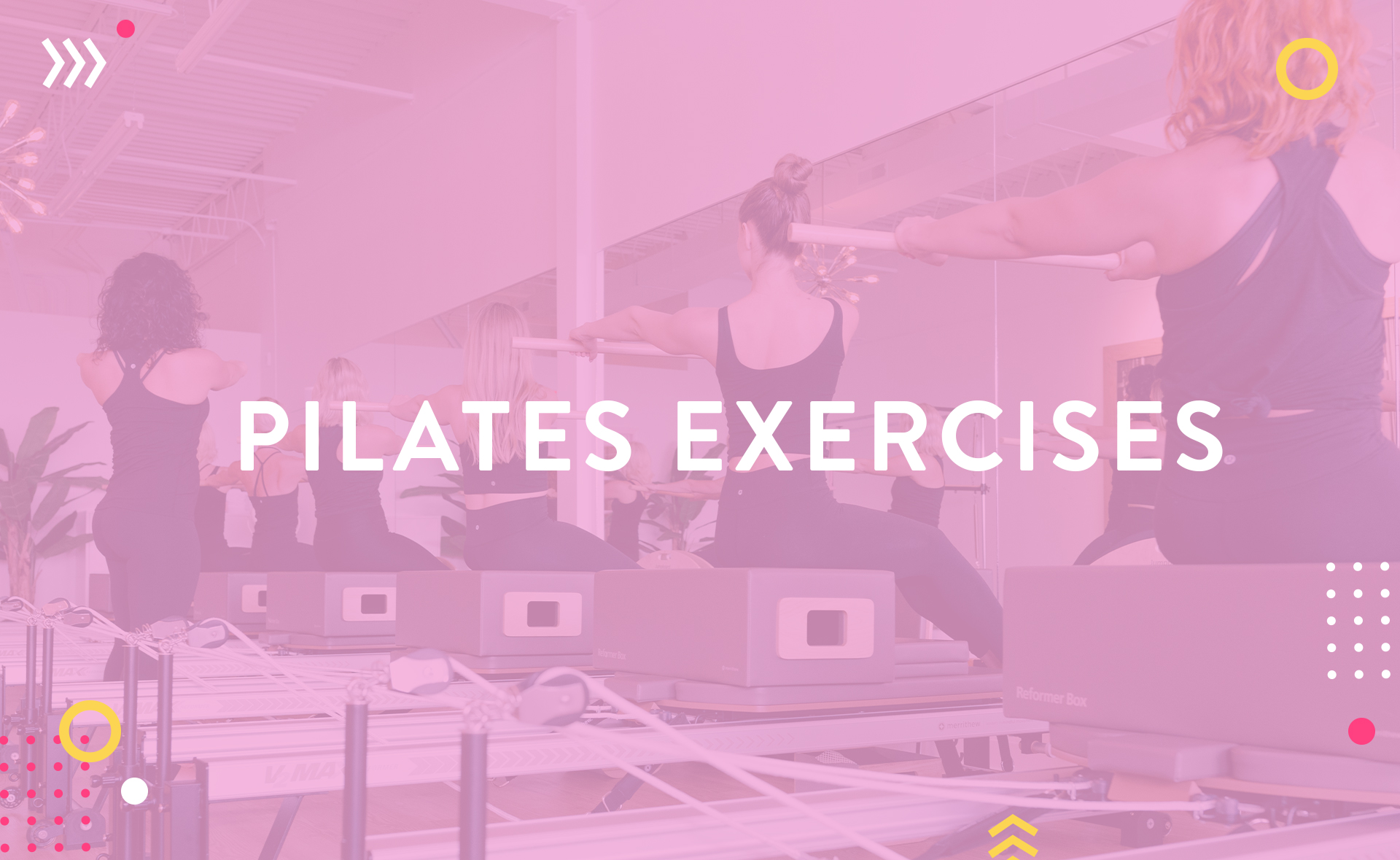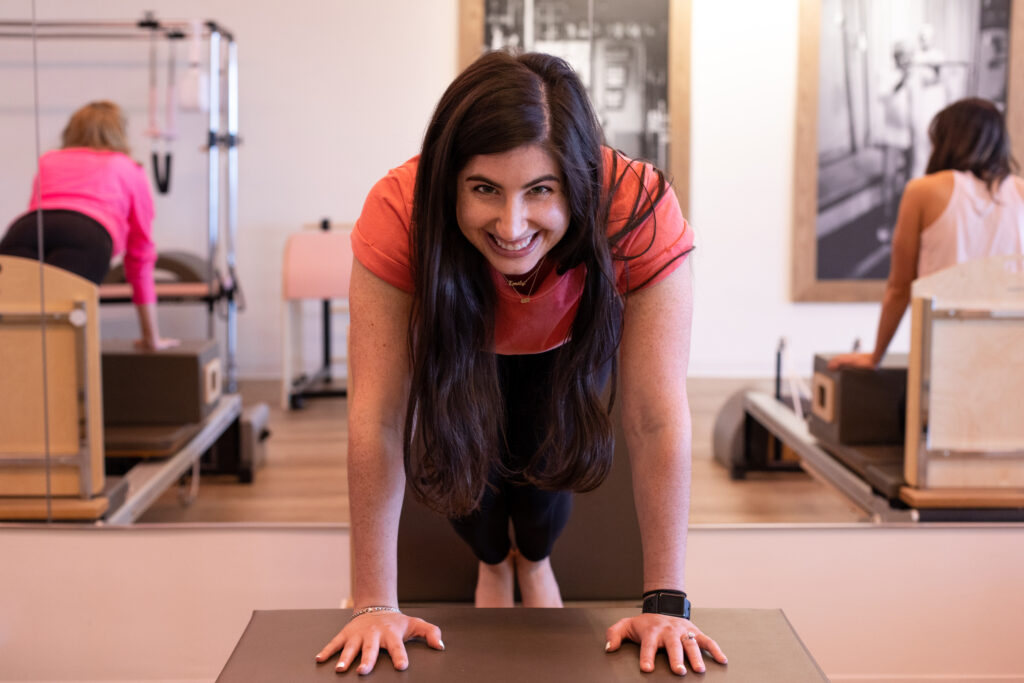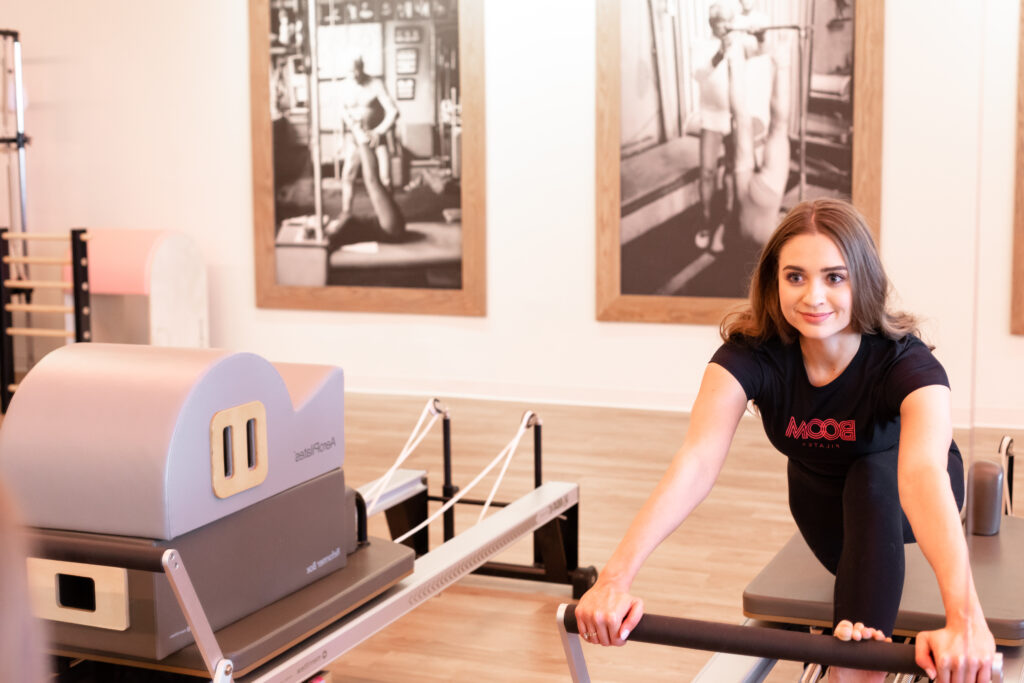
If you’ve been to the Boom Pilates studio or any other Pilates studio, then you’ve probably gone through your fair share of Pilates reformer exercises. While we rely on more tools than the reformer in our classes or private sessions, our group reformer classes are by far our most popular offering. Whether you’re a beginner on the reformer or one of our frequent flyers, this review of some of our most frequently used exercises on a Pilates reformer will help you familiarize yourself with the names and ins-and-outs of some of the moves you’ll use in class.
While there are Pilates moves that Boom loves to start beginners with, virtually all our workout routines can cater to a wide range of skill levels, which is what we at Boom refer to as repertoires (familiarity of movements, coreography or performance). This is often what our customers find most exciting about our unique classes, Pilates moves grow with you! Whether you’re on the mat or getting a good workout on the reformer, every move offered at Boom Pilates can be customized to suit your specific comfort level. Feeling a bit more pumped? Springs can be added! Not too energized? Switching out for lighter springs (or more depending on the move) or modifying components of the moves is also super easy!
For this reason, we’re going to talk about the best Pilates reformer exercises a little differently. Instead of your typical studio, which might limit these exercises by experience level, we’re going to let the exercise do the talking!
Beginner Pilates Reformer Exercises
Basic reformer exercises are good for beginners to familiarize themselves with, but they also help build a foundation for any work on the reformer that comes afterward. Beginning reformer exercises may also be referred to as “essential exercises” and are used interchangeably. These moves are what will jump-start your Pilates journey here at Boom, get you acquainted with basic reps and build the foundation for greater endurance and mental control through movement.
Beginner reformer moves then grow and develop with you! For example, a popular beginner block that we love is the Short Box Series. However, this specific section of moves can be intensified with twists, poles, limbs, leans, and spinal/posture edits.
Intermediate Pilates Reformer Exercises
Intermediate-level exercises are perfect to move into as you advance in your practice and is the most common level amongst regulars here at Boom Pilates. As we all move along in our Pilates journey, these different levels can start to build on each other. In one of our intermediate classes, for example, we might warm up with a few beginner exercises before advancing the clients into more intermediate/advanced exercises.
One of our favorite Intermediate reformer exercise blocks is the Back Rowing Series. This series of coordinated movements can truly mimic rowing a boat, but have you tried the slow-hug variation of this move? It’s pretty boomey! But totally worth the effort.
Advanced Pilates Reformer Exercises
Once you and your instructor have flawlessly covered the basics, and you are feeling like a pro with the choreography and strength required in Intermediate, the next step could be taking your journey into the advanced Pilates repertoires. While reaching this level is not as common (usually this level is performed by our most experienced BP ambassadors), it’s surely attainable with focus, practice, perseverance, and discipline.
Similar to the more intermediate exercises, warming-up with beginner-level basic principles is still recommended to encourage foundational mobility and to prep the body for more advanced stretching. More advanced Pilates moves are when all the tricks, bells and whistles come into play. These Pilates exercises truly test balance, endurance, strength, choreography and mental control to the limit through crazy trick-oriented positions. Get ready to eat your Wheeties!
Footwork
Repertoire: Beginner, Intermediate or Advanced
Some of the initial choreography we do on the reformer typically includes some footwork using the foot bar at the end of the Pilates reformer. Lying down on the carriage bed, we often warm up by properly pressing against the foot bar in order to move ourselves on the carriage track. Whether it’s used to warm up, cool down, or in the middle of class for specific choreography, mastering this heel, toe, arch footwork is fundamental in Pilates.
There are a few different positions your instructor might ask you to place your feet in during this warm-up, depending on your flexibility and repertoire level. The first is the Pilates V, where the balls of your feet are on the foot bar, heels lifted, with your legs shoulder-width apart. With a neutral spine and an engaged core, we can press away from the footbar and allow ourselves to slowly return to the bar. Here, we’re engaging the whole leg to push and return as we inhale and exhale.
There are some additional foot positions we might use while doing this kind of footwork. While in the Pilates V, we sometimes lift and lower the heels to add an extra emphasis as we push ourselves out and in. Typically, this is done after we push out with heels lifted, then we lower the heels through the footbar, lift back up and then return the carriage to the end of the reformer.
This kind of work on the reformer can also be done with the feet in different positions. One of these is like a “bird on a perch.” In the Boom Pilates studio, you might go into this position after an instructor asks you to “put on your stilettos.” That’s because this position has us up on the very tips of our feet with our toes curled around the bar. Other positions include a variation of the Pilates V with our heels touching together. Footwork is a super versatile Pilate move that can be customized easily depending on your level of experience.
Leg Circles
Repertoire: Beginner, Intermediate or Advanced
Another foundational set of exercises on the Pilates reformer are found in the feet-in-straps section of the class. Our favorite is leg circles. When we do leg
circles, the footbar goes down and our feet go into the loops attached to the reformer’s pulleys. With our feet in the loops and our backs on the carriage, we lift our legs up with control, assisted by our body weight on the reformer carriage.
For leg circles for beginners, we typically lift our legs at a 45-degree angle off the reformer and raise them to a 90-degree angle. As we use an inhale, we lift our legs, side by side, up and toward us before circling them open and away from each other as we exhale and lower them back down. Then we bring them together and upon another inhale. We repeat this several times, occasionally modifying or switching up the move by doing it in reverse or adding additional choreography to increase difficulty.
Short Box Series
Repertoire: Beginner, Intermediate or Advanced
The short box series is a staple in most classes, especially our Essential level, though it makes an appearance in more difficult classes also (with modifications or additional moves to up the intensity level). In this series, we’re seated on a box placed on the reformer carriage with our flexed feet under the strap at the end of the reformer for stability and support. From here, we can do several different exercises. Typically, with either a round back or a flat back, we recline backward slowly in a controlled movement, lifting and lowering using our core and back muscles.
Sometimes, a pole is added to this series. With one end of the pole in either hand, we do the same series of lowering and lifting, but with our arms extended holding the pole over our head. For beginners, we might do the series just like this. For added intensity at higher levels, we might add twists or extensions with the pole, complicating the choreography for more intense reps.
Elephant
Repertoire: Beginner, Intermediate or Advanced
This Pilates reformer exercise has us standing on the reformer with the foot bar lifted up. We place our feet flat on the carriage, heels pressed against the shoulder rests. With our hands shoulder-width apart on the foot bar, we move the carriage slightly toward and away from the footbar, expanding and contracting the arch we’ve formed with our bodies. This move requires us to engage our abdominal muscles and hold strength in our bodies in order to move the carriage. It is not just accomplished with a simple hinge of the hips.
Back Rowing Series
Repertoire: Essential, Intermediate or Advanced
There are many different intermediate moves and variations that can be performed on the reformer in a rowing series. For a basic row on the reformer, we first sit on the carriage facing the pulley system. Placing our legs in between the shoulder rests (either pressed together or with one leg crossed on top of the other), we hold the pulley loops in our hands. We usually begin our rowing series with a basic row, pulling the straps back with bent elbows, as if we were rowing a boat.
For a slightly different arm and back exercise, we slide the loops down our forearms so they rest above our elbows. With our arms extended at a 90-degree angle, hands pointing toward the ceiling, we move our arms forward in front of us and then return them to our sides, opening wide as we move, working our upper back.
These are only two of the many different rowing moves that can be done on the reformer, all at various levels of skill and intensity. Heavier springs can be added for greater resistance and even just a small alteration can increase the intensity of the Back Rowing Series into the more advanced.
Chest Expansion
Repertoire: Beginner, Intermediate or Advanced
For this move, we begin sitting up on the reformer, with our knees against the shoulder rests and our shins and the tops of our feet flat on the carriage bed. We take the straps into our hands, holding on to them above the loops.
On the reformers we use in the Boom Pilates studio, this is usually the part where the metal hardware connects to the loops. On an exhale, we’ll pull our arms behind us, keeping the arms and elbows straight, drawing the shoulders down and outward to open the chest. It’s important to make sure our weight is pressed evenly into our knees, shins and feet. On an inhale, we bring the arms forward, then repeat the move again. It’s important that we avoid collapsing or arching into the back or rib cage and don’t hold tension in the neck, focusing instead on the lats and backside of the arms.
A variation of this move can also be done while sitting on the reformer with our legs through the shoulder rests, similar to the position we use in the rowing series.
Teaser
Repertoire: Intermediate or Advanced
There are few Pilates reformer exercises more infamous than the teaser, and there are a number of different ways to do the exercise.
For a more essential or Intermediate version, we begin by sitting forward on the long box so that when we lie down on the box, our shoulders float off the end and hover over the well of the reformer. From here, we bring our legs into tabletop position. Grabbing the straps (possibly with your instructor’s assistance), we stretch the legs to straighten them, lifting them at a 45-degree angle off the box. Circling the arms around, we bring them forward and articulate through the back, engaging the abdominals and lifting up to make a 90-degree angle with our extended legs. Making sure to keep our shoulders back, we lower and lift the arms at our sides to move the carriage forward and backward.
Some of the variations of the teaser might come here, whether it’s in how high or low we lift the arms, or adding circular moves to the arms or legs. Either way, your instructor will guide you through the specifics of this challenging move and how to customize it to your specific needs!
Conclusion
These are just a few examples of the many different exercises we might do on the Pilates reformer. Each move can be changed and altered in class to adjust the difficulty or targeted muscles, or enhanced with additional choreography. As a contemporary studio, we love the fact that our Certified Pilates instructors can teach an entire class of people with varying levels the same move, but with customized movements, modalities or intensities to suit each person’s individual needs.
One of the beautiful things that makes Pilates unique is that everyone can advance at their own pace, and taking Pilates classes with a certified instructor is the perfect way to ensure that you get the most out of these Pilates reformer exercises.



